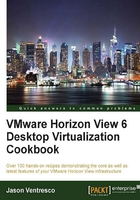
The VMware Horizon View Cloud Pod overview
A VMware Horizon View Cloud Pod, also known as a federated pod, consists of a set of Horizon View Connection Server instances, shared storage, a database server, and the vSphere and network infrastructures required to host desktop virtual machines.
In a traditional VMware Horizon View implementation, each pod is managed independently. With the Federated Pod Architecture feature introduced in Version 6, you can join together multiple pods to form a single Horizon View implementation called a pod federation.
A pod federation can span multiple sites or data centers and offers the following benefits over the previous single-pod model:
- It centrally manages Horizon View desktops located across multiple data centers.
- The desktop entitlement is managed globally, including the ability to assign desktops based on the location of the Horizon View client.
- It has the ability to balance the Horizon View Client load across multiple data centers using centralized rather than individual login portals and user entitlements.
- Users can be entitled to multiple desktop pools in up to four Horizon View pods across two sites. Rather than selecting which pool to use when logging into the Horizon View Client, the user is presented with only one pool, and the assignment of desktops is handled automatically, based on how the global entitlement is configured.
- Using federated Horizon View pods, we can enable native disaster recovery (DR) for the View infrastructure.
The following figure is an example of a basic Horizon View Cloud Pod Architecture:

In the example topology, two previously standalone Horizon View pods in different data centers are joined together to create a pod federation. In a pod federation, an end user can connect to a Horizon View Connection Server instance in the Research Triangle Park (RTP) data center and can be assigned a desktop located in a completely different pod located in the Santa Clara data center.
Sharing key data in the global data layer
The Horizon View Connection Server instances in a pod federation use something called a global data layer to share the key data. The data that is shared includes information on the pod federation topology, user and group entitlements, Horizon View policies, and other information concerning the federated pod configuration.
In a Horizon View pod federation, the shared data is replicated between every member Horizon View Connection Server instance. The entitlement and topology configuration information stored in the global data layer determines where and how desktops are allocated across the pod federation.
When the Federated Pod feature is enabled, or additional pods are added to an existing pod federation, the global data layer is configured on each VHorizon View Connection Server instance.
Sending messages between pods
The Horizon View Connection Server instances in a federated pod communicate using an interpod communications protocol called the View InterPod API (VIPA).
Horizon View Connection Server instances use the VIPA interpod communication channel to launch new desktops, find existing desktops, and share health status data and other information. The VIPA interpod communications channel is configured when the Federated Pod feature is enabled.
Federated Pod's topology limits
A VMware Horizon View Federated Pod implementation consists of two or more Horizon View pods, which are linked together to create a pod federation. The following table details the configuration limits of a Horizon View Federated Pod:

It is important to note that while a single pod can contain up to 10,000 desktops, a single Federated Pod comprised of up to four individual pods can contain 20,000 desktops at the most, even though individual pods support up to 10,000 desktops each.
Note
The topology limits of a federated pod are subject to change as new versions of Horizon with View are released. Consult the VMware Horizon with View documentation (https://pubs.vmware.com/horizon-view-60/index.jsp) for current information concerning platform limits.
A similar restriction exists for Horizon View Connection servers, where a single pod supports up to seven Connection servers in a five active plus two standby configuration, whereas a federated pod comprised of four individual pods supports a maximum of twenty Connection Servers.